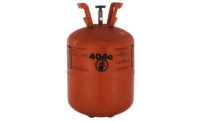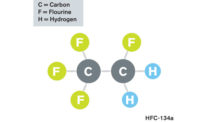What’s happening with the refrigerant blend hydrofluorocarbon (HFC)-410A (R-410A)? To answer that question, let’s start with a little background.
Hydrochlorofluorocarbon (HCFC)-22, also known as R-22, was first introduced as a replacement refrigerant for chlorofluorocarbon (CFC)-12, or R-12, in residential air conditioning applications. R-22 operated with higher pressures and was more efficient than R-12 but did not return oil back to the compressor’s crankcase as well. Once service technicians got used to the higher pressures of R-22, it serviced the HVACR industry very well for more than 50 years. For many years, R-22 was the refrigerant of choice for commercial and residential air conditioning and heat pump systems. Supermarket refrigeration systems, industrial centrifugal chillers, and industrial cooling applications also used R-22.
R-22 is a pure compound containing only one molecule. R-22 is an HCFC, meaning its molecule contains chlorine, which marks it as an ozone-depleting refrigerant (see Figure 1). Its ozone-depletion potential (ODP) is 0.055. The R-22 molecule also contains hydrogen, fluorine, and carbon. Its global warming potential (GWP) is 1,857. Because of these environmental concerns, R-22 was phased out for new equipment in the year 2010, and its total production phaseout will occur in 2020.
THE R-410A STORY
That brings us to R-410A. R-410A entered the scene as the replacement HFC-based, binary refrigerant blend for R-22 in “new” light commercial and residential air conditioning and heat pump applications. Other applications for R-410A include chillers and commercial refrigeration equipment. R-410A has higher efficiencies than R-22 in air conditioning and heat pump applications because of its 50 percent greater vapor density and 60 percent higher vapor pressure. In fact, R-410A has about a 5-6 percent higher energy efficiency rating (EER) than R-22.
The R-410A binary refrigerant blend consists of 50 percent HFC-125 (R-125) and 50 percent HFC-32 (R-32) by weight. R-410A has an ODP of zero and a GWP of 2,088. Both R-32 and R-125 are HFCs and have ODPs of zero because their molecules do not contain chlorine. R-32 has a low GWP of 675, which is favorable when transitioning to lower GWP refrigerants. R-125 on the other hand, has a high GWP of 3,400. A GWP of 3,400 means the refrigerant traps 3,400 times as much heat per kilogram than carbon dioxide does over a 100-year time period. Figures 2 and 3 illustrate the molecules of R-32 and R-125, respectively.
R-410A has an ASHRAE A1 safety classification, meaning it has low toxicity and is not flammable. Even though R-410A is a 400-series refrigerant blend, it has a very small temperature glide and negligible fractionation potential. R-410A uses synthetic polyolester (POE) lubricant and is not a retrofit refrigerant for R-22. If an R-22 system needs to be retrofitted to a different refrigerant, it is recommended to choose from a list of accepted R-22 retrofit refrigerants, such as R-407C, which have similar properties to R-22.
OPERATING PRESSURES
R-410A can have about 60 percent higher operating pressures than R-22 in air conditioning and heat pump applications. This means that at a condensing temperature of 100°F, an R-22 system would have a condensing pressure of 196 psig while an R-410A system would have a condensing pressure of 317 psig. Because of this, R-22 service equipment, such as gauge sets, hoses, recovery equipment, and cylinders, cannot be used with R-410A unless they have been certified for use with it. Designers of R-410A systems have specified greater wall thicknesses for compressors and even filter driers. Gauge and manifold sets used on R-410A systems have much higher ranges of 800 psi on the high side and 250 psig on the low side.
In most cases, equipment designed for R-22 cannot use R-410A because of the differences in operating pressures. This is one of the reasons retrofitting an R-22 system to R-410A is normally not an option. It is strongly recommended for service technicians to be voluntarily certified in handling the higher operating pressures of R-410A.
LEGISLATION
Because of its somewhat high GWP value, the U.S. Environmental Protection Agency (EPA), under its Significant New Alternatives Policy (SNAP) program, has listed R-410A as “unacceptable” and has delisted the refrigerant in the following categories:
- New vending machines as of Jan. 1, 2019;
- New stand-alone medium-temperature units with a compressor capacity below 2,200 Btuh and not containing a flooded evaporator as of Jan. 1, 2019;
- New stand-alone medium-temperature units with a compressor capacity equal to or greater than 2,200 Btuh and stand-alone medium-temperature units containing a flooded evaporator as of Jan. 1, 2020;
- New stand-alone low-temperature units as of Jan. 1, 2020; and
- New chiller applications as of Jan. 1, 2024.
R-410A REPLACEMENT OPTIONS
Notice in the above SNAP program’s bullet list of “unacceptable” or delisted refrigerant categories for R-410A, there is no category mention of air conditioning, heat pump, or chiller applications. This is because there are no nonflammable alternatives on the market at the time of this article for these applications to replace R-410A. There are, however, a few mildly flammable refrigerant alternative candidates for these applications. Two of the mildly flammable alternative candidates for R-410A in air conditioning and heat pump applications are mentioned below. With this said, the days of R-410A being the commercial and residential air conditioning and heat pump refrigerant of choice could be numbered.
HFC-32 (R-32) is a mildly flammable refrigerant used in air conditioning and heat pump applications. It is a chlorine-free, single-component refrigerant and consists of only one molecule. As mentioned above, it has a GWP of 675, which is 75 percent lower than that of R-410A, and an ODP of zero. R-32 also has about a 1.5-times higher heat transfer capacity than R-410A. A higher heat transfer capacity allows for R-32 to have a much smaller refrigerant charge volume than other refrigerants.
R-32 is currently being used in millions of air conditioning and heat pump units worldwide. Japan, Thailand, Australia, India, and other Asian and European countries all use R-32 in their air conditioning and heat pump systems. R-32 is easier to recover, recycle, and reuse than R-410A. Because R-32 is mildly-flammable, it has an A2L ASHRAE safety classification and is subject to certain use conditions. A2L means the refrigerant has low toxicity and is mildly flammable.
R-452B is a mildly flammable alternative refrigerant blend candidate for R-410A in air conditioning and heat pump applications. R-452B is a blend of HFC-32, HFC-125, and hydrofluoroolefin (HFO)-1234yf. R-452B also has an A2L safety classification. It has a GWP of 675 and exhibits lower discharge temperatures and lower flammability than R-32. It has a very low temperature glide. R-452B has been designed to replace R-410A in air conditioning, chiller and heat pump applications.
At the time of this writing, much research is still being done on mildly flammable refrigerants, including R-32 and R-452B.
Publication date: 7/3/2017
Want more HVAC industry news and information? Join The NEWS on Facebook, Twitter, and LinkedIn today!












